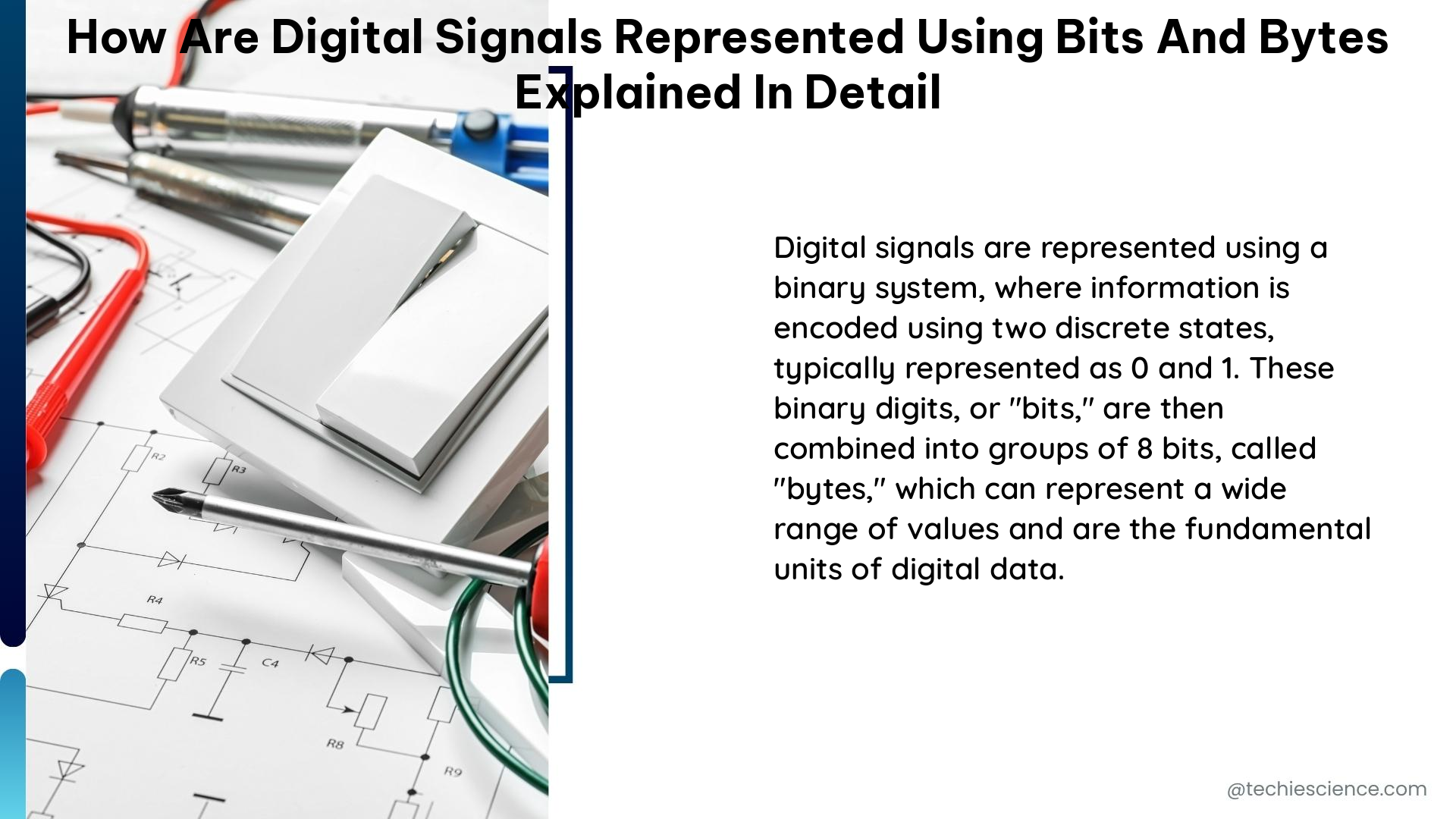Digital signals are the foundation of modern electronics and computing, and understanding how they are represented using bits and bytes is crucial for any electronics student or enthusiast. This comprehensive guide will delve into the intricate details of digital signal representation, providing you with a deep understanding of the underlying principles and practical applications.
The Basics of Bits and Bytes
At the most fundamental level, digital signals are represented using binary digits, or “bits.” A bit is the smallest unit of digital information and can have only two possible values: 0 or 1. These binary values are the building blocks of digital systems, allowing for the representation of a wide range of data, including text, images, and sound.
A byte, on the other hand, is a group of 8 bits. This grouping allows for the representation of 256 (2^8) different values, which is the foundation for the storage and manipulation of digital data. Each position in a binary number has a specific place value, such as 2^0, 2^1, 2^2, and so on, enabling the conversion between binary and decimal numbers.
Arithmetic Operations in the Binary Number System

The binary number system follows the same rules as the decimal system when it comes to arithmetic operations, with a few key differences. In the binary system, each digit can only have a value of 0 or 1, and the carry or borrow from the next digit must be taken into account.
For example, to add two binary numbers, you would follow the same steps as in decimal addition, but with the added rule that the sum of two 1s is 10 (1 in the next column and 0 in the current column). Similarly, subtraction, multiplication, and division can be performed in the binary number system, with the appropriate adjustments for the base-2 representation.
Representing Analog Signals Digitally
Analog signals, such as sound and images, cannot be directly represented using bits and bytes. Instead, they must be digitized through a process called sampling and quantization.
Sampling involves taking frequent measurements of the analog signal at regular intervals, while quantization assigns a numerical value to each sample based on a predetermined range of values. These numerical values can then be easily translated into binary form, allowing digital devices to process and store the information.
For example, in CD audio, the sampling rate is 44,100 samples per second, with an accuracy of 1 in 65,536 distinct levels (16-bit quantization). This high sampling rate and resolution ensure that the digital representation of the audio signal closely matches the original analog waveform.
Parallel and Serial Data Transfer
Digital signals can be transmitted in two primary formats: parallel and serial. In parallel data transfer, multiple bits are sent simultaneously, with each pin representing a different bit of the digital number. This allows for faster data transfer rates but requires more physical connections between the transmitting and receiving devices.
In serial data transfer, on the other hand, each bit of the digital number is sent one after the other on a single pin. While this method is slower than parallel transfer, it requires fewer physical connections, making it more practical for certain applications, such as long-distance communication.
Quantifiable Details and Data Points
To further enhance your understanding of digital signal representation, let’s explore some key quantifiable details and data points:
Bit and Byte Representation
- A single bit can represent two different values (0 or 1).
- A byte is a group of 8 bits, which can represent 256 different values (2^8).
Audio Data Representation
- The sampling rate for CD audio is 44,100 samples per second.
- CD audio has an accuracy of 1 in 65,536 distinct levels (16-bit quantization).
- The CD audio data rate is 1,411,200 bits per second (176,400 bytes per second).
Frequency and Sampling Rates
- The frequency range of human hearing is approximately 20 Hz to 20 KHz.
- The Nyquist sampling rate for CD audio is twice the highest frequency (44,100 samples per second).
Conversion Formulas and Examples
- Binary to decimal conversion: decimal_value = 1×2^0 + 1×2^1 + 0x2^2 + 1×2^3
- Example: Representing the decimal number 11 in binary: 11 = 1×2^3 + 0x2^2 + 1×2^1 + 1×2^0 = 1011
- Example: Converting the binary number 1011 to decimal: decimal_value = 1×2^3 + 0x2^2 + 1×2^1 + 1×2^0 = 1 + 0 + 2 + 8 = 11
Conclusion
Digital signals are the foundation of modern electronics and computing, and understanding how they are represented using bits and bytes is essential for any electronics student or enthusiast. This comprehensive guide has provided you with a deep dive into the intricacies of digital signal representation, covering the basics of bits and bytes, arithmetic operations in the binary number system, the digitization of analog signals, and the principles of parallel and serial data transfer.
By mastering the concepts and techniques presented in this guide, you will be well-equipped to tackle more advanced topics in digital electronics and signal processing. Remember to refer to the quantifiable details and data points provided throughout the article to solidify your understanding and apply these principles in your own projects and studies.
Reference:
- Bits, Bytes, Gigs, and Other Technology Jargon
- Representing information
- Bits, Bytes and Binary number system – CuriouSTEM
- Digital data – MakeCode Adafruit
- Bits, bytes, and representation of information – cs.Princeton

The lambdageeks.com Core SME Team is a group of experienced subject matter experts from diverse scientific and technical fields including Physics, Chemistry, Technology,Electronics & Electrical Engineering, Automotive, Mechanical Engineering. Our team collaborates to create high-quality, well-researched articles on a wide range of science and technology topics for the lambdageeks.com website.
All Our Senior SME are having more than 7 Years of experience in the respective fields . They are either Working Industry Professionals or assocaited With different Universities. Refer Our Authors Page to get to know About our Core SMEs.